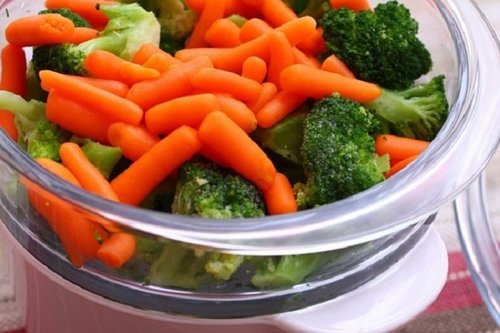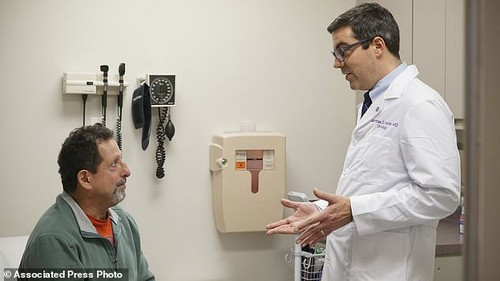In order to properly organize nutrition with biliary dyskinesia, you need to determine the cause and type of disorders.
Nutritionists insist on contraindications to chewing gum. It helps to increase the secretion of gastric juice, violates the natural regulation process.
Dietary nutrition for biliary dyskinesia in the initial stages of the disease helps to normalize the functional state of the digestive system. For the right choice you need to identify the type of violations and patiently follow the rules.
In adults, the main ones are:
- excessive consumption of fatty meat foods;
- alcohol;
- periods of starvation (doubtful diet for weight loss);
- in women – hormonal imbalance during pregnancy and during menopause;
- chronic diseases of the digestive system;
- long intense nervous work, stress.
Snacking gently and on the go violates the absorption of food
For a child more important are:
- in preschool age, the underdevelopment of the biliary system;
- in adolescents – hormonal changes;
- unorganized food (significant breaks, lack of hot dishes);
- the use of fast food, fat chips, sweet sparkling water;
- worm infection;
- acute infectious diseases;
- inadequate physical and nervous stress, leading to nervous breakdowns.
In order to avoid another exacerbation, in addition to the diet for dyskinesia, it is necessary to change the lifestyle, the choice of products, abandon bad habits, control the regimen and frequency of nutrition.

How do bile ducts depend on food?
Bile is produced in the liver. The task of the gallbladder is the accumulation of the necessary supply and release at the “request” that comes reflexively along the nerve fibers. The signal arrives at the time of the transition of the food lump from the stomach to the duodenum.
The muscular wall of the bladder begins to contract, transmitting movement to the bile duct. Thus, a portion of bile acids passes through the sphincter of Oddi into the intestines and is involved in digestion.
How long and how consistently muscle fibers will contract depends on the quality and mass of food in the stomach:
- If the food consisted of an abundance of fatty, spicy dishes, then the stomach holds it up to 12 hours (at a rate of 6-8). All this time there is an increased secretion of bile, a reduction in the duct.
- When eating low-fat food without overeating, bile quickly enters the intestine, due to short-term contraction of the bladder. Then he relaxes and again accumulates discharge from the hepatic passages.
The work of bile secretion directly depends on the nature of the food. Digestion is provided by the coordinated function of the participating systems. Adaptation, stages of contraction and relaxation are provided by nervous regulation. When it is disrupted, dyskinesia of the gallbladder and ducts occurs.
Using a diet for biliary dyskinesia, it is possible to achieve a consistent rational alternation of muscle activity to remove bile.
Depending on the nature of the disorders in dyskinesia, 3 types are distinguished:
- hypertonic – muscle tone is significantly increased, spasmodic contractions, sharply painful for the patient;
- hypotonic – a decrease in tone promotes the accumulation and overstretching of the bladder, disrupts the outflow of bile, and causes stagnation;
- mixed – the nature of dyskinesia changes, often accompanies the organic pathology of the biliary tract.
How to distinguish between types of dyskinesia?
The diet for gallbladder dyskinesia depends on a predominantly hypo- or hypertonic form of impaired contraction. It is possible to accurately identify the type of DZHVP using a full examination. It is recommended that the patient judge the nature of dyskinesia by symptomatology.
With the hypotonic type, constant pains are aching, aching in the hypochondrium on the right, varying in intensity, a feeling of bitterness in the mouth, periodically nausea and vomiting, a tendency to constipation, increased fatigue in school and work, constant weakness.
The hypertonic type is characterized by paroxysmal sharp pains, ongoing contractions, with localization in the hypochondrium on the right, due to increased physical exertion, a tendency to diarrhea, nausea, sometimes vomiting with bile, decreased appetite, frequent headaches, sweating, and attacks of rapid heartbeat.
Patients with biliary dyskinesia are clearly irritable, conflicting in the team, constantly complain of weakness
What are the basic rules to follow when dieting?
Regardless of the type of dyskinesia, the patient should strive to fulfill the main requirements:
- completely eliminate from the diet non-recommended foods;
- provide frequent meals (up to 5 times) in small portions;
- to cook food only boiled, stewed, steamed, refuse frying, smoking, baking with crusts;
- follow the feeding schedule, try to eat at one time;
- do not eat up at night, dine no later than 3-4 hours before bedtime;
- refuse hot or too cold food (causes additional spasm and irritation).
It depends on the survey data, the patient’s condition. According to Pevzner’s classification, the basic dietary table is No. 5. A correction is made to it depending on the type of dyskinesia and concomitant diseases of the digestive system.
Dietary nutrition with hypotonic form
With dyskinesia of this type, a diet No. 5 l / f (lipotropic fat) is used. Its purpose: to stimulate the contractile function of the gallbladder, to provide a choleretic effect with entry into the intestine, to normalize fat metabolism.
To do this, the menu includes:
- an increased amount of fat with a minimum cholesterol content, provided that half the dose is due to vegetable;
- fiber of vegetable fiber from fruits, vegetables, impurities of bran.
The diet allows unmilled food, so it does not require mashed potatoes, minced meat.
Vegetable oils activate the production of prostaglandins, which contribute to the dilution of the consistency of bile, enhance muscle activity during dyskinesia. They are recommended for refueling ready meals, salads. During heat treatment, the properties are significantly lost.
Wheat bran – used to reduce cholesterol in bile, improve outflow. It should be added to cereals, soups, jelly or eat separately. The diet restricts (with excess weight completely eliminates) easily digestible carbohydrates (sugar, honey, preserves, cakes, confectionery), which contribute to stagnation of bile in the bladder.
It is better to pour boiling water over the bran and wait for the swelling
Great attention should be paid to the protein content. It should be provided with low-fat meat and fish dishes, dairy products. Especially useful are products that include a high concentration of lipotropic substances due to the ability to normalize fat metabolism and cholesterol. And this prevents the precipitation of crystals and the further formation of stones in bile.
The most valuable are:
- cottage cheese, milk;
- egg protein;
- fish and lean meats.
Strengthening of bile secretion during dyskinesia is facilitated by vegetable dishes, fruits, berries and juices from them. They also stimulate intestinal motility and relieve constipation. These properties are quite pronounced in oranges, tangerines, prunes, pears, watermelons, pumpkins, avocados, and greens (dill, spinach, rhubarb).
What can be eaten and forbidden with hypomotor dyskinesia?
Recommended nutritionists meals and products include:
- vegetarian soups;
- low-fat chicken, beef broths;
- boiled or stewed meat, fish;
- inedible pastries, dried bread, biscuit, dry cookies;
- vermicelli, noodles, boiled pasta;
- milk and dairy products of medium fat content (kefir, sour cream, cottage cheese, yogurt, cheese);
- cereals in the form of dressings for soups, cereals (buckwheat, oatmeal, wheat);
- butter and vegetable oil;
- fruits, berries and fresh juices from them (apricots, apples, strawberries, plums);
- fresh vegetables (salads) and boiled in soups, hodgepodge, vinaigrette, the most useful are zucchini, beets, carrots;
- tea from herbs (chamomile, with oregano), rosehip broth, compote and berry jelly;
- marmalade, candy, marshmallows.
Prohibited products are:
- rich meat and fish broths;
- cooking oil, fat;
- smoked meat products;
- mushrooms and cabbage in any form;
- pickles and pickles;
- hot sauces, mayonnaise, ketchup;
- legumes;
- baking, cakes, culinary products from puff and shortcrust pastry;
- chocolate, coffee, cocoa;
- ice cream;
- sparkling water.
How to eat with a hyperkinetic form?
With increased contractions of the bile duct caused by dyskinesia, the diet should provide maximum sparing of the liver and other digestive organs, inhibition of bile synthesis. The safest conditions are provided by option 5shch.
It is different:
- mechanical sparing (mashed dishes);
- reducing the amount of fat in both animal and vegetable;
- an increase in the proportion of light carbohydrates;
- reduction in the use of fiber, extractive substances;
- a ban on raw vegetables and fruits.
More attention is paid to cooking methods: frying is strictly forbidden, a double boiler, stewing should be used.
Pain with different types of dyskinesia is different in nature.
What is recommended to eat with hyperkinetic dyskinesia?
The following products and dishes are most suitable for patients with hyperfunctional dyskinesia:
- mashed vegetable soups with cereal dressing;
- boiling semi-liquid porridge from oatmeal, rice, buckwheat (wheat, millet and barley are not allowed daily);
- steam cutlets, meatballs, meatballs are prepared from lean meat of chicken, turkey, rabbit, veal;
- spicy boiled sausage is rarely allowed;
- boiled low-fat fish is prepared in broth, meatballs, meatballs;
- eggs in a protein omelet;
- only wheat bread, dried, in crackers;
- vegetable dishes stewed in mashed potatoes from cauliflower, carrots, potatoes, pumpkin, zucchini;
- milk, low-fat cottage cheese, kefir, yogurt;
- sour cream is allowed to use for refueling dishes no more than three times a week;
- from sweet berries and fruits prepare juice, compote, jelly, mousse, casserole;
- honey in the absence of acute symptoms of the disease and good tolerance;
- some jam, marmalade, pastille.
It is recommended to limit or exclude from food: canned meat, fish, vegetables, hot seasonings, garlic and onions, mustard, horseradish, mushrooms, fried eggs and boiled eggs, offal, fatty meat and fish (rich in cholesterol), vegetable fiber (due to radish, radishes, cucumbers, bran, bell peppers), extractives from broths, raw fruits and vegetables.
Any type of dyskinesia is accompanied by irritability of the patient, in practice, patients reach a neurotic state. It is proved that in such cases magnesium-containing foods should be added to the diet: nuts, sesame and pumpkin seeds (can be crushed), boiled seaweed, buckwheat porridge. How long will have to follow a diet in a particular case will tell the doctor. Nutritionists believe that at least six months.
Features of diet therapy for children
DZHVP occurs in childhood quite often. Parents do not always attach importance to temporary pains and complaints, catch on when the symptoms become apparent, and are often repeated. If a child refuses food, doesn’t want to eat even his favorite dish, adults should be wary of his state of health.
In childhood, functional changes are best treated by diet. Compliance with nutritional requirements before the period of growing up teaches the child to choose the right products, reduces the risk of developing chronic pathology.
How strict is the diet required for dyskinesia?
The rules of diet therapy require:
- cook food by steam, boiling or baking, exclude fried foods;
- provide a feeding regimen at least five times a day with an interval of 4 hours;
- monitor the amount of food, one serving for a student should be no more than 250 g in weight;
- exclude overeating on holidays, forced starvation diets;
- serve warm dishes to the table, you can’t feed with cold or too hot items;
- dinner should be 3-4 hours before bedtime.
- chopping food is necessary only with the hypertonic type of dyskinesia;
- calories should correspond to the age, weight and energy consumption of the child;
- butter is allowed from animal fats, it contains arachidonic acid and retinol useful for the child’s body, is well absorbed;
- broths are limited due to the high concentration of extractives;
- it is necessary to ensure that the child does not eat chips, salted nuts, fast food products, sausages, chocolate;
- of drinks, sweet soda, fresh juices, coffee, cocoa are strictly contraindicated; you can drink green or herbal tea, rosehip broth, compotes and jelly.



